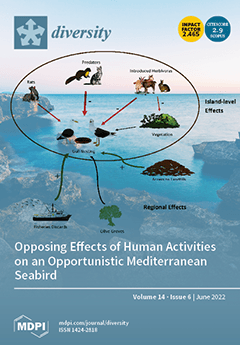Assessment of benthic diversity and estuarine ecological quality is becoming increasingly important. Estuaries are not only highly productive and variable environments, but they are also areas of high anthropogenic perturbations. In this study, benthic macrofauna were sorted, identified and analyzed from a freshwater-dominated
[...] Read more.
Assessment of benthic diversity and estuarine ecological quality is becoming increasingly important. Estuaries are not only highly productive and variable environments, but they are also areas of high anthropogenic perturbations. In this study, benthic macrofauna were sorted, identified and analyzed from a freshwater-dominated tropical estuary along the Bay of Bengal to assess their community structure, distribution and functional guilds, and to uncover the environmental drivers influencing their distributional patterns. Results revealed that the studied physio-chemical variables (DO, pH, alkalinity and temperature) were significantly varied (
p < 0.05) among the sites.
Capitella sp. was dominant (18%) of the forty morphospecies recorded, indicating organic richness of the area. The ANOVA results revealed that macrobenthic density differed significantly (
p < 0.01) between the study locations, and diversity indices (Shannon diversity index, H′) also differed significantly (F
4,12 = 5.89;
p = 0.02). The benthic density decreased from the head to the mouth, which could be related to salinity fluctuations and large freshwater discharges. Upstream sites were completely segregated from downstream and mid-estuarine sites, according to cluster analysis (CA). The SIMPER results clarified the site grouping pattern, showing that
Mysis-1 spp.,
Capitella spp. and
Nephtys-1 were the most significant contributors. From the communities, five functional trophic groups were identified where deposit feeders were the most dominant (66.44%). Most of the macrobenthos had strong positive correlations with DO (r = 0.92) and water temperature (r = 0.86) and a negative correlation with soil pH (r = −0.28), per correlation and CCA analyses. Individually, soil pH (r = 0.88) and alkalinity (r = 0.898) showed strong positive correlation with
Capitella sp. and
Chironomus sp.2. The above results indicate that macrobenthos of this estuary do not follow the usual pattern of spatial distribution, and they are structured by DO, alkalinity and soil pH. In addition, dominance of some pollution indicator species (
Capitella sp. and
Chironomus sp.) and deposit feeders indicates a poor ecological condition of the estuary.
Full article





